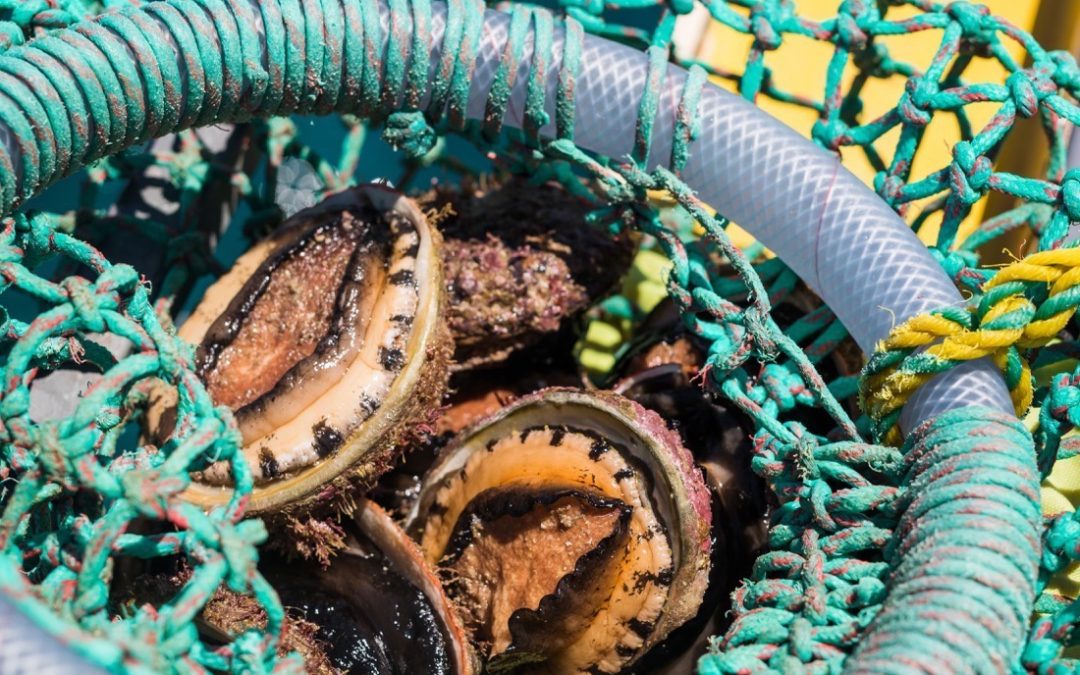They’re the bigfoot of the ocean floor. The humble abalone (Haliotis) is a marine snail — or more precisely a univalve mollusc with a flat, smooth, pale, oval shell, containing a large muscular “foot” with a frill or lip. This rounded foot is very large in comparison to most molluscs. They like hanging around on rocks or reefs, often fairly close to shore. Once they’ve set up camp, these sucker snails are bloody hard to pry loose without a bit of sharp persuasion. There are salty tales of free divers drowning while trying to lever stubborn abalone off rocks with their hands, trapping their fingers in the process — a bit like that episode of The Simpsons where Homer gets his hand stuck in a vending machine but won’t let go of the chocolate bar.
This is because the meat of this mollusc is considered a delicacy in a lot of places including Latin America, France, New Zealand and most of Asia. The Chinese rate it as a luxury food, in the same zone as shark fin or bird’s nest soup, to star on the menu at special occasions such as weddings.
In Japan, live and raw abalones are used in sushi, or steamed, salted, boiled, chopped, or simmered in soy sauce. In California, they put it on pizza or eat it like a steak. This popularity on the palate has led to the development of a substantial export market for abs, which fetch big figures, currently around $100/kg, exported live to Asia. The ab industry has seen its fair share of cowboys hunting fast overnight dollars.
As with many molluscs, the process of raising a family is pretty random. Mamma abalone shoots up to two million eggs into the water world through a row of holes in the shell. Ab sperm is spread the same way. The Captain is thinking it must get a bit soupy down below when abalone are in a lovin’ mood. The fertilised eggs grow into pin head-sized larvae, drifting around in the currents until they get fat enough to sink to the bottom — where it’s potluck if they find a good piece of real estate. If they make it past egghood, the juveniles learn to hide under rocks and in caves, but still get gobbled up by crabs, lobsters, octopuses, starfish, fish and other sea snails. As they grow larger and get their personal armour happening, they become braver and less afraid of the light, planting their sucker feet in more accessible areas.
Lots of predators are partial to abalone. Mature abs are on the menu for fish, rays and, of course, blokes in diving suits. Abs are also prone to various diseases. In 2007 something called ganglioneuritis killed up to 90 per cent of abs in some areas of Victoria. These snails are a bit like the haemophiliac royal families of Europe as their fluids will not clot if they get a laceration or puncture wound.
Abs go by a number of aliases — ear shells, sea ears, muttonfish or muttonshells in Australia, ormer in the UK, perlemoen (pearl moon) in South Africa, bao yu in China and pāua in New Zealand — are a few. But however they try to hide, there’s no escaping the fact that they’re transporting some pretty tasty mollusc meat inside that mother-ofpearl shell house. Those thick iridescent shells are also popular for decorative use — jewellery or inlay — and for those still partial to a durry, they make pretty useful ashtrays (I know, disgusting habit, really should give it up).
The shells are damn tough, made of tiny calcium carbonate tiles stacked like bricks and stuck together with a sort of protein glue. When the abalone shell is hit, the tiles slide instead of shattering and the protein stretches to absorb the energy of the blow. So rugged is this underwater body armour, that scientists are studying it for clues about making stronger, er, body armour. The majority of abalone species are found in cold waters off the coasts of New Zealand, South Africa, Australia, western North America, and Japan.
There are 18 abalone species in Australian waters including greenlip, blacklip, tiger (a hybrid of blacklip and greenlip), brownlip and Roe’s abalone. The greenlip (Haliotis laevigata) is found along Australia’s southern coast, off Victoria, South Australia, northern Tasmania and Western Australia. It’s the most common aquaculture species, farmed mainly in South Australia.
Blacklip abalone (Haliotis rubra) is endemic to Oz and the most common species in NSW, Victoria and Tasmania, found from Ceduna (South Australia) to Ballina (NSW). Tasmania has the largest wild harvest blacklip abalone fishery in Australia. And just so you know: scuba diving for abalone in NSW and WA is illegal; a “generous” free-diving catch limit of two is allowed.





Recent Comments